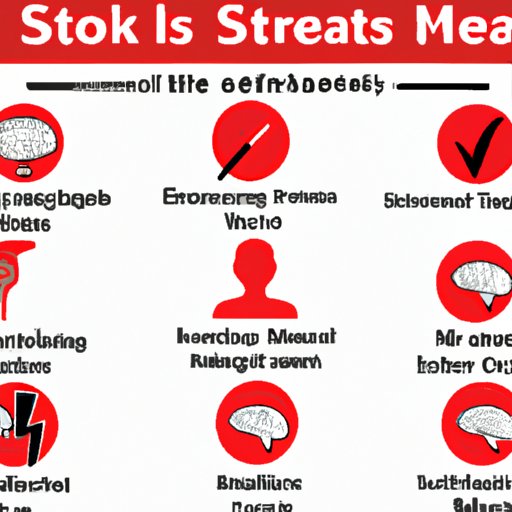I. Introduction
Strokes are one of the leading causes of death and disability worldwide, making it vital to understand the warning signs and early detection. In this article, we will explore the key symptoms associated with a stroke and the importance of immediate medical attention. We’ll also discuss preventative measures, early warning signs, and the potential effects of delayed treatment.
II. The Silent Signs of A Stroke You Should Never Ignore
A stroke is a medical emergency that occurs when the blood supply to the brain is interrupted or reduced. The impact of a stroke can be severe, causing long-term disability, brain damage, or death. Although there are some noticeable symptoms, there are also silent signs that you should never ignore. These signs include sudden confusion or trouble speaking, difficulty with vision, or sudden numbness or weakness, particularly on one side of the body.
The importance of medical attention cannot be overstated. In some cases, the effects of a stroke can be mitigated or even reversed with immediate medical intervention.
III. Unmasking A Stroke: Common Symptoms Explained
When it comes to recognizing a stroke, it’s crucial to understand the common symptoms that may occur. The symptoms can vary depending on the type of stroke. The most common symptoms of a stroke include sudden numbness or weakness, particularly on one side of the face, arm, or leg. In some cases, a stroke may also cause sudden confusion, difficulty speaking, loss of balance, or trouble with vision in one or both eyes.
It’s essential to pay attention to the sudden onset of symptoms. Any of these symptoms may develop quickly or worsen over time. The speed at which the symptoms manifest can depend on the severity of the stroke, making immediate treatment even more critical.
IV. How to Recognize the Early Warning Signs of Stroke
Early recognition of stroke warning signs can be lifesaving. It’s crucial to recognize when a stroke may be occurring to seek immediate treatment. One of the most effective ways to do this is to understand the acronym FAST (Face drooping, Arm weakness, Speech difficulty, Time to call).
If any of these symptoms occur, acting FAST can make all the difference. This means calling emergency services immediately and noting the time that the symptoms first started.
Other potential early warning signs of a stroke may include a severe headache, dizziness or loss of coordination, difficulty swallowing or speaking, or sudden confusion or memory loss. If you experience any of these symptoms, it’s essential to seek medical attention immediately.
V. When Time is Brain: Identifying the Symptoms of a Stroke
Understanding the time-sensitive nature of stroke treatment is crucial. The longer a stroke goes untreated, the more severe the damage to the brain can be. Every minute counts when it comes to the treatment of a stroke. Identifying the symptoms of a stroke and seeking immediate medical attention is essential to improving your chance of recovery.
Delayed treatment can lead to irreversible brain damage, cognitive impairment, or even death. It’s crucial to understand the severity of stroke and why immediate medical care is essential.
VI. Spotting the Symptoms of a Stroke – Early Detection is Key
Identifying the symptoms of a stroke is only one aspect of preventing and treating this medical emergency. Preventative measures can also help reduce your risk of having a stroke. Understanding and managing risk factors such as high blood pressure, smoking, obesity, and diabetes can reduce your chance of having a stroke.
Additionally, making lifestyle changes such as eating a healthy diet, exercising regularly, getting enough sleep, and managing stress are all important to your overall health & wellbeing.
Monitoring for potential warning signs is also an essential aspect of preventative care. Understanding your body and recognizing potential warning signs early can help you seek treatment immediately, reducing the likelihood of stroke or its severe effects.

VII. From Numbness to Confusion: Recognizing the Symptoms of a Stroke
In addition to the commonly recognized symptoms of a stroke, other symptoms may manifest throughout the body. For example, numbness or weakness may extend beyond one side of the body. Additionally, a stroke may cause confusion, memory loss, or difficulty understanding what someone else is saying.
There can also be global effects, which may include difficulty swallowing or a persistent headache. When a stroke progresses, the initial symptoms may worsen or new symptoms may arise.
VIII. Conclusion
Knowing the symptoms of a stroke and understanding the importance of immediate medical attention is essential to improving recovery. By recognizing the early warning signs, taking preventative measures, and acting FAST, you can reduce the likelihood of having a stroke and reduce its serious effects. It’s imperative to remain vigilant and take care of your overall health to reduce your risk of a stroke occurrence.
Remember, even if you’re unsure if you’re experiencing a stroke, seeking medical attention immediately is critical. Time is brain and getting the appropriate treatment can make all the difference.
